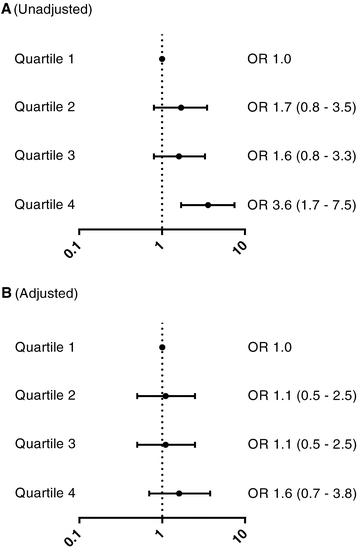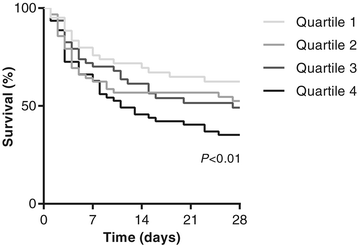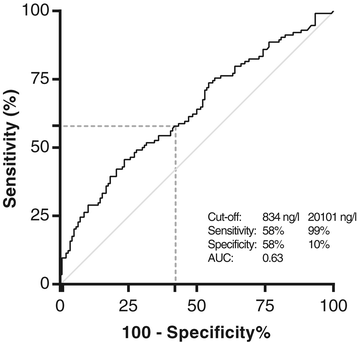NT-proBNP in cardiopulmonary resuscitated patients treated with mild therapeutic hypothermia is not independently associated with mortality: a retrospective observational study
- PMID: 25883532
- PMCID: PMC4399224
- DOI: 10.1186/s12871-015-0023-y
NT-proBNP in cardiopulmonary resuscitated patients treated with mild therapeutic hypothermia is not independently associated with mortality: a retrospective observational study
Abstract
Background: In spite of the introduction of mild therapeutic hypothermia (MTH), mortality rates remain high in patients with return of spontaneous circulation (ROSC) after cardiac arrest (CA). To date, no accurate and independent biomarker to predict survival in these patients exists. B-type natriuretic peptide (BNP) was found to provide both prognostic and diagnostic value in various cardiovascular diseases, including survival to hospital discharge in patients with ROSC. However, the biologically inactive counterpart of BNP, NT-proBNP, was found to be a more stable and accurate analyte. The current retrospective observational study investigates the value of NT-proBNP to predict 28-day mortality in post-CA patients treated with MTH, as well as the dynamics of NT-proBNP during MTH.
Methods: NT-proBNP levels were measured in post-CA patients cooled via cold intravenous saline infusion and water-circulating body wraps (Medi-Therm®, Gaymar). Plasma samples were obtained before cooling was started, at the start and end of the maintenance phase and at the end of rewarming.
Results: 250 patients, admitted between 2009 and 2013, had NT-proBNP levels measured on ICU admission and were included for the evaluation of NT-proBNP as a prognostic marker. In the 28 days following ICU admission, 114 patients died (46%). Non-survivors had significantly higher NT-proBNP (median 1448 ng/l, IQR 366-4623 vs median 567 ng/1, IQR 148-1899; P < 0.001) levels on ICU admission. Unadjusted odds ratios for 28-day mortality were 1.7 (95% CI 0.8-3.5), 1.6 (0.8-3.3) and 3.6 (1.7-7.5) for increasing quartiles of NT-proBNP as compared to the lowest quartile. Adjusted odds ratios were 1.1 (95% CI 0.5-2.5), 1.1 (0.5-2.5) and 1.6 (0.7-3.8), respectively. A cut-off value of 834 ng/l achieved a sensitivity of 58% and a specificity of 58% to predict 28-day mortality. Of 113 patients, NT-proBNP values of each MTH phase were available and grouped in decreased or increased levels in time. Both decreases and increases of NT-proBNP values were observed during the MTH phases, but presence of either was not associated with outcome.
Conclusions: High NT-proBNP plasma concentrations on ICU admission are associated with high 28-day mortality in post-CA patients treated with MTH in a univariate analysis, but not in a multivariate analysis. Increases or decreases of NT-proBNP levels during MTH appear unrelated to 28 day mortality.
Keywords: Cardiac arrest; Mild therapeutic hypothermia; NT-proBNP; Natriuretic peptides.
Figures




Similar articles
-
[The predictive value of plasma N-terminal pro-B-type natriuretic peptide levels in the evaluation of prognosis and the severity of patients with septic shock induced myocardial suppression].Zhonghua Wei Zhong Bing Ji Jiu Yi Xue. 2013 Jan;25(1):40-4. doi: 10.3760/cma.j.issn.2095-4352.2013.01.011. Zhonghua Wei Zhong Bing Ji Jiu Yi Xue. 2013. PMID: 23611096 Chinese.
-
N-terminal B-natriuretic Peptide after coronary artery bypass graft surgery.J Cardiothorac Vasc Anesth. 2009 Apr;23(2):147-50. doi: 10.1053/j.jvca.2008.10.002. Epub 2008 Dec 21. J Cardiothorac Vasc Anesth. 2009. PMID: 19103499
-
[Prognostic value of N terminal pro B type natriuretic peptide in critically ill patients].Zhongguo Wei Zhong Bing Ji Jiu Yi Xue. 2011 Mar;23(3):179-82. Zhongguo Wei Zhong Bing Ji Jiu Yi Xue. 2011. PMID: 21366951 Chinese.
-
Changes of natriuretic peptides predict hospital admissions in patients with chronic heart failure: a meta-analysis.JACC Heart Fail. 2014 Apr;2(2):148-58. doi: 10.1016/j.jchf.2013.11.007. JACC Heart Fail. 2014. PMID: 24720923 Review.
-
The predictive value of plasma biomarkers in discharged heart failure patients: role of plasma NT-proBNP.Minerva Cardioangiol. 2016 Apr;64(2):157-64. Epub 2015 Sep 15. Minerva Cardioangiol. 2016. PMID: 26373781 Review.
Cited by
-
Increased B-type-natriuretic peptide promotes myocardial cell apoptosis via the B-type-natriuretic peptide/long non-coding RNA LSINCT5/caspase-1/interleukin 1β signaling pathway.Mol Med Rep. 2015 Nov;12(5):6761-7. doi: 10.3892/mmr.2015.4247. Epub 2015 Aug 25. Mol Med Rep. 2015. PMID: 26323562 Free PMC article.
-
N-terminal pro-B-type natriuretic peptide as a prognostic indicator for 30-day mortality following out-of-hospital cardiac arrest: a prospective observational study.BMC Cardiovasc Disord. 2020 Aug 24;20(1):382. doi: 10.1186/s12872-020-01630-x. BMC Cardiovasc Disord. 2020. PMID: 32838754 Free PMC article.
-
Emergency Department Point-of-Care Tests during Cardiopulmonary Resuscitation to Predict Cardiac Arrest Outcomes.J Emerg Trauma Shock. 2023 Apr-Jun;16(2):48-53. doi: 10.4103/jets.jets_138_22. Epub 2023 May 22. J Emerg Trauma Shock. 2023. PMID: 37583382 Free PMC article.
-
ICU 'Magic Numbers': The Role of Biomarkers in Supporting Clinical Decision-Making.Diagnostics (Basel). 2025 Apr 11;15(8):975. doi: 10.3390/diagnostics15080975. Diagnostics (Basel). 2025. PMID: 40310334 Free PMC article. Review.
-
Initial Phase NT-proBNP, but Not Copeptin and High-Sensitivity Cardiac Troponin-T Yielded Diagnostic and Prognostic Information in Addition to Clinical Assessment of Out-of-Hospital Cardiac Arrest Patients With Documented Ventricular Fibrillation.Front Cardiovasc Med. 2018 Jun 7;5:44. doi: 10.3389/fcvm.2018.00044. eCollection 2018. Front Cardiovasc Med. 2018. PMID: 29930943 Free PMC article.
References
-
- Peberdy MA, Callaway CW, Neumar RW, Geocadin RG, Zimmerman JL, Donnino M, et al. Part 9: post-cardiac arrest care: 2010 American Heart Association Guidelines for Cardiopulmonary Resuscitation and Emergency Cardiovascular Care. Circulation. 2010;122:S768–86. doi: 10.1161/CIRCULATIONAHA.110.971002. - DOI - PubMed
Publication types
MeSH terms
Substances
LinkOut - more resources
Full Text Sources
Other Literature Sources
Medical
Research Materials
Miscellaneous

